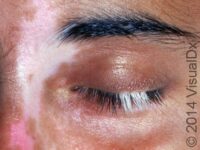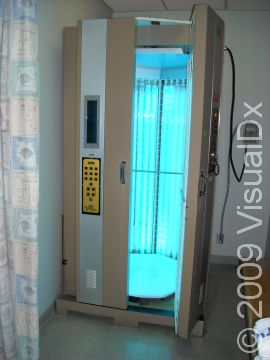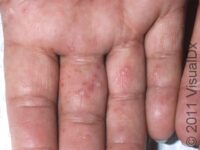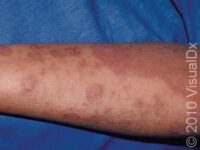
Phototherapy
Phototherapy uses ultraviolet (UV) light under medical supervision to treat certain skin diseases. Depending on the type of UV treatment and the type of skin disorder being treated, phototherapy may be delivered for several seconds to minutes per session, usually 2-3 times per week. Phototherapy may be used alone or in combination with topical or oral (systemic) medications, depending on what your medical professional has determined is best for your skin condition.
Common types of UV light treatment include:
- Narrowband UVB light treatments (311 nanometer wavelength only).
- Broadband UVB light therapy (280-320 nanometer wavelengths).
- PUVA (320-400 nanometer wavelengths of light). This is UVA light therapy combined with an oral light-sensitizing medication known as psoralen.
Skin disorders that can be treated with phototherapy include, for example:
A significant time commitment is necessary to achieve clear skin with phototherapy. These sessions are usually scheduled 2-3 times per week, depending on the skin condition and severity. It may take as many as 30 sessions to completely clear psoriasis lesions, for example. Once the skin is clear, phototherapy treatments can be stopped or can be continued on a routine “maintenance” basis.
People with chronic skin conditions who become more experienced with the procedure and who are comfortable self-administering light therapy may be prescribed a light-therapy unit for use at home, following their medical professional’s recommendations.
What to Expect During Your Visit
Each therapy session is supervised by a medical professional experienced in phototherapy treatments, such as a dermatologist. The first few therapy sessions are shorter, and then session time gradually increases once your response to therapy has been assessed by your medical professional. People with lighter skin colors start with shorter times of exposure compared to people with darker skin colors.
The areas of your body requiring treatment will need to be exposed (ie, you may need to disrobe), while unaffected areas of the body are protected from UV light exposure. Wearing special goggles helps prevent the risk of UV-induced cataracts. During treatment, you will stand in front of a light box lined with vertical fluorescent UV lamps.
Sometimes, your medical professional may recommend mineral oil be applied to scaly areas, such as in psoriasis, to ensure even exposure of each skin area to the light.
What to Expect After Your Visit
Following treatment, you may experience skin redness initially. With time and future therapy, you should notice an improvement in the condition the phototherapy is treating.
Follow-Up Care
Following treatment, you should wear sun-protective clothing and a broad-spectrum sunscreen daily. People undergoing PUVA therapy should also wear sunglasses to prevent eye damage as a result of the psoralen-induced light sensitivity.
Risks and Potential Side Effects
Following treatment, you may experience:
- Skin redness that should fade within 24 hours.
- Dry skin.
- Nausea (most often when taking psoralen).
- Skin color changes such as dark spots on the skin as the condition resolves; this is more common in darker-skinned individuals.
- Reactivation of cold sores (herpes simplex virus).
- A sunburn-like reaction with or without skin blistering may sometimes occur.
Note that there is increased risk of skin cancer development with long-term phototherapy, as well as early skin aging (freckles, wrinkles, age spots, etc.)
People who should not receive phototherapy include those who:
- Have an allergy to sunlight.
- Have a history of skin conditions that worsen with UV light exposure (eg, lupus, types of porphyria).
- Have a history of melanoma or certain other skin cancers.
- Take medications that make them sensitive to UV light.
When to Seek Medical Care
Contact your medical professional if you experience:
- Nausea, itching, or redness of the skin that lasts longer than 24 hours.
- Skin blistering.
- Signs of an infection (eg, pain, spreading redness, or fever).
- Vision problems that occur following treatment.
References
AAD. Psoriasis treatment: phototherapy. AAD. https://www.aad.org/public/diseases/psoriasis/treatment/medications/phototherapy. Accessed 2024 April 19.
Jaleel T, Pollack BP, Elmets CA. Phototherapy. In: Kang S, Amagai M, Bruckner AL, Enk AH, Margolis DJ, McMichael AJ, Orringer JS, eds. Fitzpatrick’s Dermatology. 9th ed. New York, NY: McGraw-Hill Education; 2019.
Last modified on May 16th, 2024 at 3:56 pm

Not sure what to look for?
Try our new Rash and Skin Condition Finder



